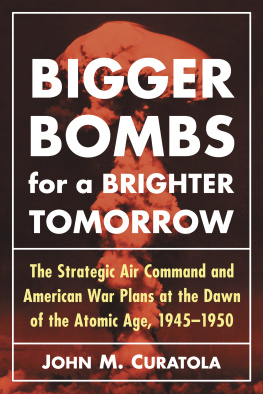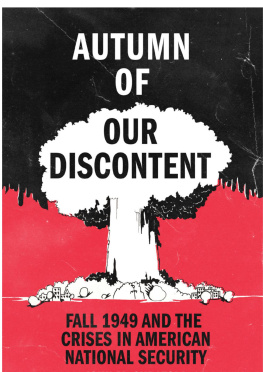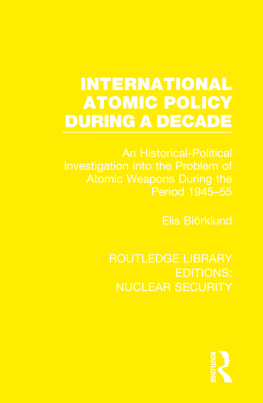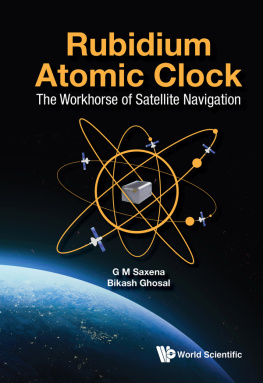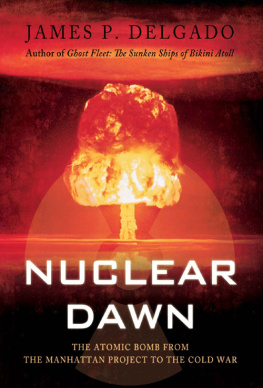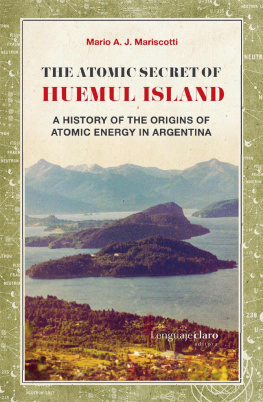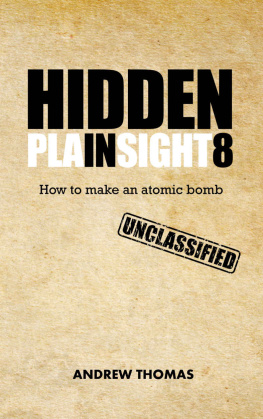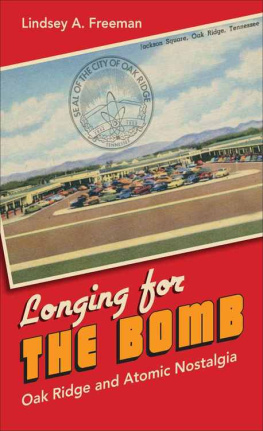
Bigger Bombs for a Brighter Tomorrow
The Strategic Air Command and American War Plans at the Dawn of the Atomic Age, 19451950
JOHN M. CURATOLA

McFarland & Company, Inc., Publishers
Jefferson, North Carolina
LIBRARY OF CONGRESS CATALOGUING DATA ARE AVAILABLE
BRITISH LIBRARY CATALOGUING DATA ARE AVAILABLE
e-ISBN: 978-1-4766-2137-1
2016 John M. Curatola. All rights reserved
No part of this book may be reproduced or transmitted in any form or by any means, electronic or mechanical, including photocopying or recording, or by any information storage and retrieval system, without permission in writing from the publisher.
On the cover: Mushroom cloud from the Able test of Operation Crossroads in the Bikini Atoll on July 1, 1946 (Joint Army/Navy Task Force One)
McFarland & Company, Inc., Publishers
Box 611, Jefferson, North Carolina 28640
www.mcfarlandpub.com
For my two greatest joys:
Jenny and Katie
Preface
For almost fifty years, the Strategic Air Command (SAC) was on the front line of the Cold War. Sitting atop the most potent and powerful weapons ever devised, the men and women of SAC stood as the bulwark against potential Communist expansion. With Peace is our Profession as their motto, SAC aircrews and personnel stood in a combat-ready status for most of the commands existence and dutifully served as defenders of the free world. A diversified force with both manned bomber aircraft and intercontinental ballistic missiles, SAC was capable of delivering megatons worth of destruction upon the Soviet Union and her Warsaw Pact allies. Keepers of much of the nations atomic weaponry, SAC provided considerable deterrent power for the U.S. military and offset the Red Armys numerical superiority. In addition to the destructive force inherent in its weapons, SAC also employed some of the most sophisticated intelligence-gathering platforms ever devised by man in order to try to gain a full appreciation of Soviet military posture and dispositions. From the 1950s up to the commands deactivation in 1992, SAC evolved into one of the most potent and professional military organizations ever constructed.
However, this incredible destructive power and professional acumen were not created overnight, nor were SACs capabilities developed with a set procedural template. Military innovation is not a straightforward process and does not necessarily follow a given set of rules or procedures. Rather, developing new military capabilities and applications is often a messy process full of miscalculation, blunder, and confusion. The growth of SAC was no different. While the command eventually developed a global reach with enormous firepower, it started inauspiciously after the Second World War and had to mature over a number of years. Developing a global atomic strike force required assistance from other segments of the federal government and national agencies. SAC was subject to political winds, the vagaries of the budget, and changes in national sentiment. Its history is also replete with compromises, setbacks, and in some cases abject failures.
During the first few years of the commands existence, SAC was hardly a competent, capable military force. It was initially plagued by faulty leadership, poor resources, substandard training, and legacy equipment. After the war, SAC suffered the exodus of thousands of seasoned veterans. In addition to its internal problems, SAC also suffered from a lack of a coherent national strategy for the use of atomic weapons. Furthermore, SAC lacked guidance regarding U.S. goals and objectives vis--vis the Soviet Union. War plans in the late 1940s were infeasible, based upon capabilities that SAC did not possess, and the few capabilities SAC did have were not aimed at any particular political objective. Even if SAC did have the assets and training to execute the established war plans, what was a strategic bombing offensive supposed to accomplish if it had to go to war in the late 1940s? This question remained largely unanswered.
Furthermore, as the nations only atomic delivery force at the time, SAC had very little control over or access to the weapons it was supposed to deliver. After the war, the Atomic Energy Commission (AEC) assumed control of all the materials left over from the Manhattan Project. As the custodians of Americas atomic monopoly, the AEC jealously guarded fissionable materials and sought to limit military access to the few atomic components the nation had on hand. The AEC had its own organizational issues that precluded production of fissionable materials. While SAC had its internal problems, the nascent AEC and the inherited atomic infrastructure from the war were also in poor shape.
The confluence of these factors made SAC (and Americas atomic monopoly during the late 1940s) a paper tiger with very little ability to prosecute war and leverage the nuclear advantage. While the Truman administration placed many of its military eggs into the atomic basket, there was very little capability actually resident in the nations strategic bombing armada, with fissionable material also in short supply. Trying to offset the Red Armys numerical superiority, SAC and the atomic bomb served as the nations primary foil against Communist expansion. Had the nation chosen to press its atomic prerogative, SAC would have been hard-pressed to execute the kinds of missions envisioned in any of the established war plans. Plain and simple, the nation was bluffing with regard to its atomic arsenal and capability, and most Americans were ignorant of the situation.
A number of published works discuss this particular topic. Harry Borowskis A Hollow Threat was one of the first books that highlighted the poor state of the postwar air force and its inability to conduct atomic warfare. His work, along with Walton Moodys detailed analysis in Building a Strategic Air Force and William Borgiaszs The Strategic Air Command, provided an excellent account regarding the internal functioning of SAC and its lack of capability during this period. These works have also been augmented recently by Phillip Meilingers 2012 work Bomber: The Formation and Early Years of Strategic Air Command. All of these works have been useful in the development of this treatise. However, in 1990 Stephen Ross and David Allen Rosenberg provided the Cold War historian a great service by doing yeomans work of making available, and publishing in their original form, the approved war plans developed during the immediate postwar period. These primary source documents are invaluable to the historian trying to gain an appreciation of American military thinking on war with the Soviets. Furthermore, in this series Ross and Rosenberg also published the Weapon System Evaluation Group Report of February 1950 that shed considerable light on the efficacy of the planned aerial offensive. Moreover, in 2006, a declassified SAC commanders briefing from April 1950 became available. This briefing provides unique insight regarding the state of the command late in 1949 and its ability to support the OFFTACKLE war plan. Included with the brief are parts of the commanders narrative comments and transcripts that elaborate further on the challenges facing both the nation and the Air Force. From these last two sources, this book draws heavily.
This book critically reviews the most prominent war plans during the postwar era and compares them with the actual capability resident in both SAC and other national organizations, specifically the AEC. What is found paints an even drearier picture of American atomic warfare capabilities than what previous books have articulated. This work looks at all three levels of war regarding the atomic aerial offensives in the various plans from 1945 to 1950. Review of the strategic, operational, and tactical levels of war shows that neither the AEC nor SAC were in position to execute or sustain either a conventional or atomic offensive against the USSR. While previous works discuss the larger strategic and operational issues facing SAC, this book seeks to provide greater depth, not only regarding the operational-level issues, but at the tactical level of the aerial offensive. It is at this tactical level that SACs limitations are clearly illustrated and plainly evident.
Next page
